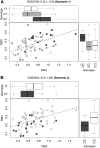Drought Sensitivity of Norway Spruce at the Species' Warmest Fringe: Quantitative and Molecular Analysis Reveals High Genetic Variation Among and Within Provenances
- PMID: 29440346
- PMCID: PMC5873913
- DOI: 10.1534/g3.117.300524
Drought Sensitivity of Norway Spruce at the Species' Warmest Fringe: Quantitative and Molecular Analysis Reveals High Genetic Variation Among and Within Provenances
Abstract
Norway spruce (Picea abies) is by far the most important timber species in Europe, but its outstanding role in future forests is jeopardized by its high sensitivity to drought. We analyzed drought response of Norway spruce at the warmest fringe of its natural range. Based on a 35-year old provenance experiment we tested for genetic variation among and within seed provenances across consecutively occurring strong drought events using dendroclimatic time series. Moreover, we tested for associations between ≈1,700 variable SNPs and traits related to drought response, wood characteristics and climate-growth relationships. We found significant adaptive genetic variation among provenances originating from the species' Alpine, Central and Southeastern European range. Genetic variation between individuals varied significantly among provenances explaining up to 44% of the phenotypic variation in drought response. Varying phenotypic correlations between drought response and wood traits confirmed differences in selection intensity among seed provenances. Significant associations were found between 29 SNPs and traits related to drought, climate-growth relationships and wood properties which explained between 11 and 43% of trait variation, though 12 of them were due to single individuals having extreme phenotypes of the respective trait. The majority of these SNPs are located within exons of genes and the most important ones are preferentially expressed in cambium and xylem expansion layers. Phenotype-genotype associations were stronger if only provenances with significant quantitative genetic variation in drought response were considered. The present study confirms the high adaptive variation of Norway spruce in Central and Southeastern Europe and demonstrates how quantitative genetic, dendroclimatic and genomic data can be linked to understand the genetic basis of adaptation to climate extremes in trees.
Keywords: Picea abies; drought tolerance; genetic association; repeatability; single nucleotide polymorphism; wood anatomy; xylem.
Copyright © 2018 Trujillo-Moya et al.
Figures






Similar articles
-
Silver fir and Douglas fir are more tolerant to extreme droughts than Norway spruce in south-western Germany.Glob Chang Biol. 2017 Dec;23(12):5108-5119. doi: 10.1111/gcb.13774. Epub 2017 Jun 26. Glob Chang Biol. 2017. PMID: 28556403
-
Distinct genecological patterns in seedlings of Norway spruce and silver fir from a mountainous landscape.Ecology. 2017 Jan;98(1):211-227. doi: 10.1002/ecy.1632. Ecology. 2017. PMID: 28052396
-
Wood structural differences between northern and southern beech provenances growing at a moderate site.Tree Physiol. 2014 Aug;34(8):882-93. doi: 10.1093/treephys/tpu069. Epub 2014 Aug 27. Tree Physiol. 2014. PMID: 25163729
-
Predicting phenotypic variation from genotypes, phenotypes and a combination of the two.Curr Opin Biotechnol. 2013 Aug;24(4):803-9. doi: 10.1016/j.copbio.2013.03.004. Epub 2013 Mar 26. Curr Opin Biotechnol. 2013. PMID: 23540420 Review.
-
Estimating heritable genetic contributions to innate immune and endocrine phenotypic correlations: A need to explore repeatability.Horm Behav. 2017 Feb;88:106-111. doi: 10.1016/j.yhbeh.2016.11.015. Epub 2016 Nov 29. Horm Behav. 2017. PMID: 27913139 Review.
Cited by
-
Tree Resilience Indices of Norway Spruce Provenances Tested in Long-Term Common Garden Experiments in the Romanian Carpathians.Plants (Basel). 2024 Aug 6;13(16):2172. doi: 10.3390/plants13162172. Plants (Basel). 2024. PMID: 39204608 Free PMC article.
-
De novo transcriptome sequencing and gene co-expression reveal a genomic basis for drought sensitivity and evidence of a rapid local adaptation on Atlas cedar (Cedrus atlantica).Front Plant Sci. 2023 Apr 19;14:1116863. doi: 10.3389/fpls.2023.1116863. eCollection 2023. Front Plant Sci. 2023. PMID: 37152146 Free PMC article.
-
The GenTree Dendroecological Collection, tree-ring and wood density data from seven tree species across Europe.Sci Data. 2020 Jan 2;7(1):1. doi: 10.1038/s41597-019-0340-y. Sci Data. 2020. PMID: 31896794 Free PMC article.
-
Individual reproductive success in Norway spruce natural populations depends on growth rate, age and sensitivity to temperature.Heredity (Edinb). 2020 Jun;124(6):685-698. doi: 10.1038/s41437-020-0305-0. Epub 2020 Mar 16. Heredity (Edinb). 2020. PMID: 32203247 Free PMC article.
-
Revealing the Complex Relationship Among Hyperspectral Reflectance, Photosynthetic Pigments, and Growth in Norway Spruce Ecotypes.Front Plant Sci. 2022 May 30;13:721064. doi: 10.3389/fpls.2022.721064. eCollection 2022. Front Plant Sci. 2022. PMID: 35712586 Free PMC article.
References
-
- Allen C. D., Macalady A. K., Chenchouni H., Bachelet D., McDowell N., et al. , 2010. A global overview of drought and heat-induced tree mortality reveals emerging climate change risks for forests. For. Ecol. Manage. 259(4): 660–684. 10.1016/j.foreco.2009.09.001 - DOI
-
- Aloni R., 2013. The role of hormones in controlling vascular differentiation, pp. 99–140 in Cellular aspects of wood formation, edited by J. Fromm. Springer, Heidelberg: 10.1007/978-3-642-36491-4_4 - DOI
-
- Auer I., Böhm R., Jurkovic A., Orlik A., Potzmann R., et al. , 2005. A new instrumental precipitation dataset in the greater alpine region for the period 1800–2002. Int. J. Climatol. 25(2): 139–166. 10.1002/joc.1135 - DOI
Publication types
MeSH terms
Substances
LinkOut - more resources
Full Text Sources
Other Literature Sources
